FAQ: Greetings in English
1. What’s the difference between “Hello” and “Hi”?
“Hello” is a standard greeting, while “Hi” is more casual and informal.
2. When should I use “Good morning,” “Good afternoon,” or “Good evening”?
Use “Good morning” until noon, “Good afternoon” from noon until around 5 or 6 pm, and “Good evening” afterward.
3. Is “Hey” an appropriate greeting for all situations?
“Hey” is informal and best used with friends or people you know well. It may not be suitable for formal settings.
4. Can I use “What’s up?” with my boss?
It depends on the work culture and your relationship with your boss. In a more relaxed environment, it might be okay, but in a formal setting, it’s better to stick to traditional greetings.
5. How do I greet a group of people?
You can use “Hello everyone” or “Hi all.”
7. How do I greet someone I’ve met before but don’t know well?
A simple “Hello” followed by their name is polite and shows recognition.
8. What are some greetings specific to certain regions or cultures in English?
In some southern parts of the U.S., “Howdy” is a casual greeting. In Australia, “G’day” is popular.
9. How do I respond to “How are you?”
Common responses include “I’m good, thanks,” “I’m well,” or “I’m doing fine.”
10. Can I use “Goodnight” as a greeting?
No, “Goodnight” is typically used as a farewell before parting for the night.
If you have further questions or suggestions about anything specific related to this topic or anything else related to learning English as a second language, feel free to ask me in the comment box. You may also help the ESLA community by putting your valuable suggestions here to help every member improve their English language skills.
English Greetings for Emails and Letters
19. Dear
This greeting is commonly used in formal correspondence and professional settings. It indicates respect and maintains a polite tone. Including the recipient’s name makes it more personal.
20. Dear Sir or Madam
It shows respect and professionalism, making it a good option for things like job applications, formal inquiries, or letters to unknown recipients.
21. To whom it may concern
This greeting is appropriate when addressing general inquiries, formal complaints, or other situations where the recipient’s identity is unknown or irrelevant. This greeting has less of a personal touch, so best not to use it with someone you are more familiar with!
And of course, once you’ve nailed the introductions, there’s another set of phrases you need to learn.
That’s right, farewells (saying goodbye)! This video will give you a brief introduction to saying goodbye in English.
I hope you enjoy trying out these new English greetings. You’ll find that greeting people in different ways will help your English sound more natural, and it might even make English greetings more fun and interesting for you.
Download:
This blog post is available as a convenient and portable PDF that you
can take anywhere.
Click here to get a copy. (Download)
And One More Thing…
If you like learning English through movies and online media, you should also check out FluentU. FluentU lets you learn English from popular talk shows, catchy music videos and funny commercials, as you can see here:
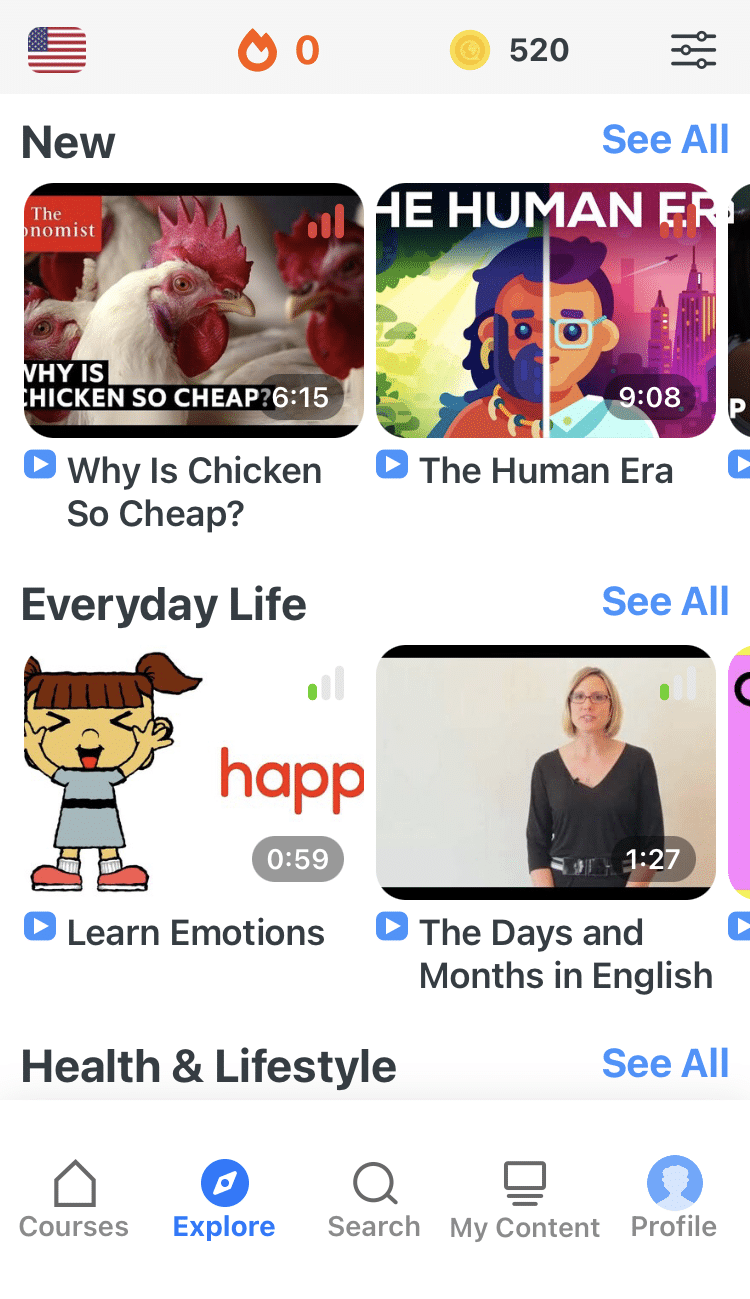
If you want to watch it, the FluentU app has probably got it.
The FluentU app and website makes it really easy to watch English videos. There are captions that are interactive. That means you can tap on any word to see an image, definition, and useful examples.
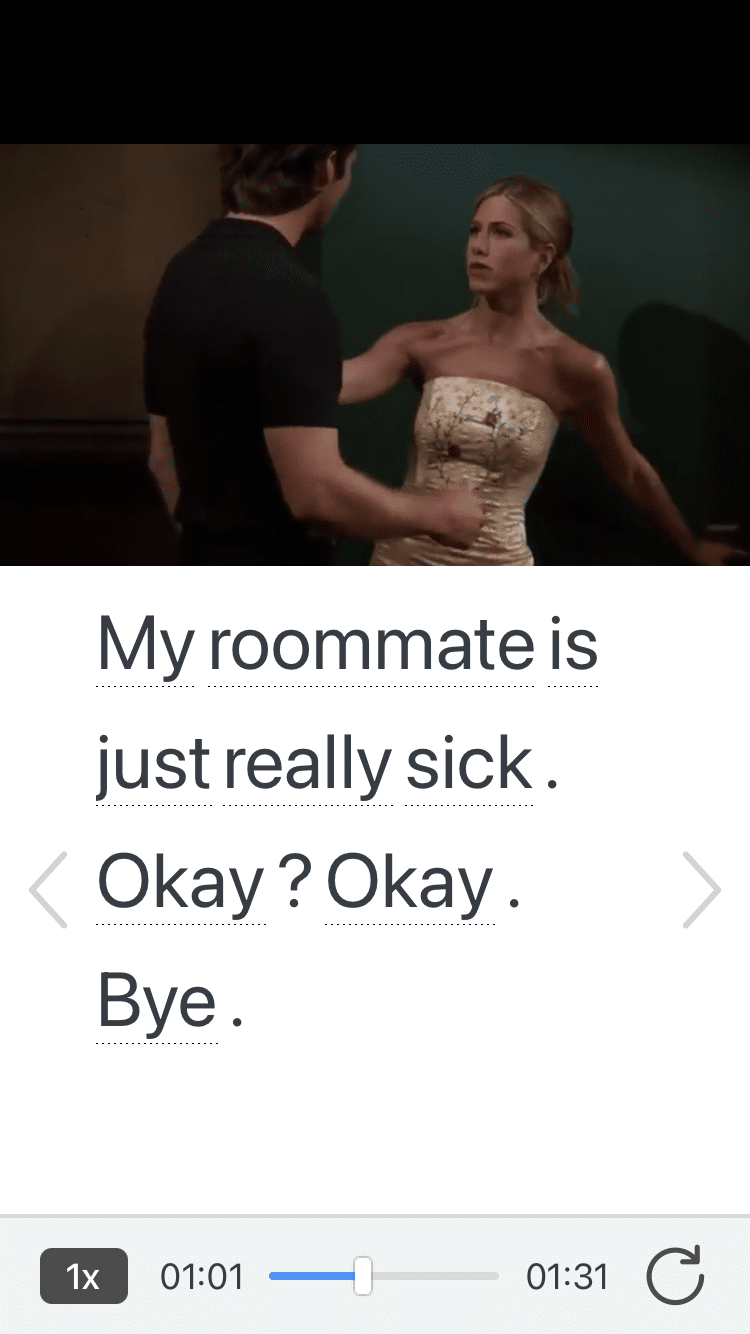
FluentU lets you learn engaging content with world famous celebrities.
For example, when you tap on the word «searching,» you see this:
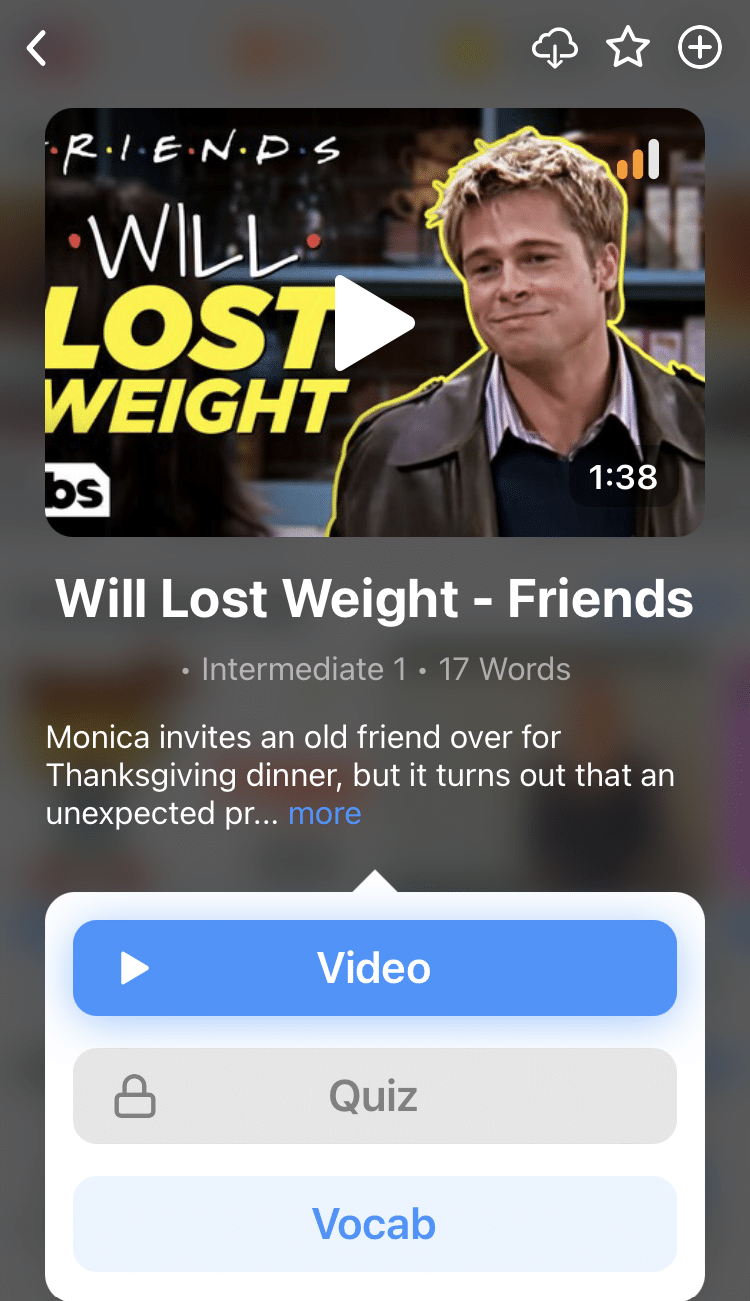
FluentU lets you tap to look up any word.
Learn all the vocabulary in any video with quizzes. Swipe left or right to see more examples for the word you’re learning.
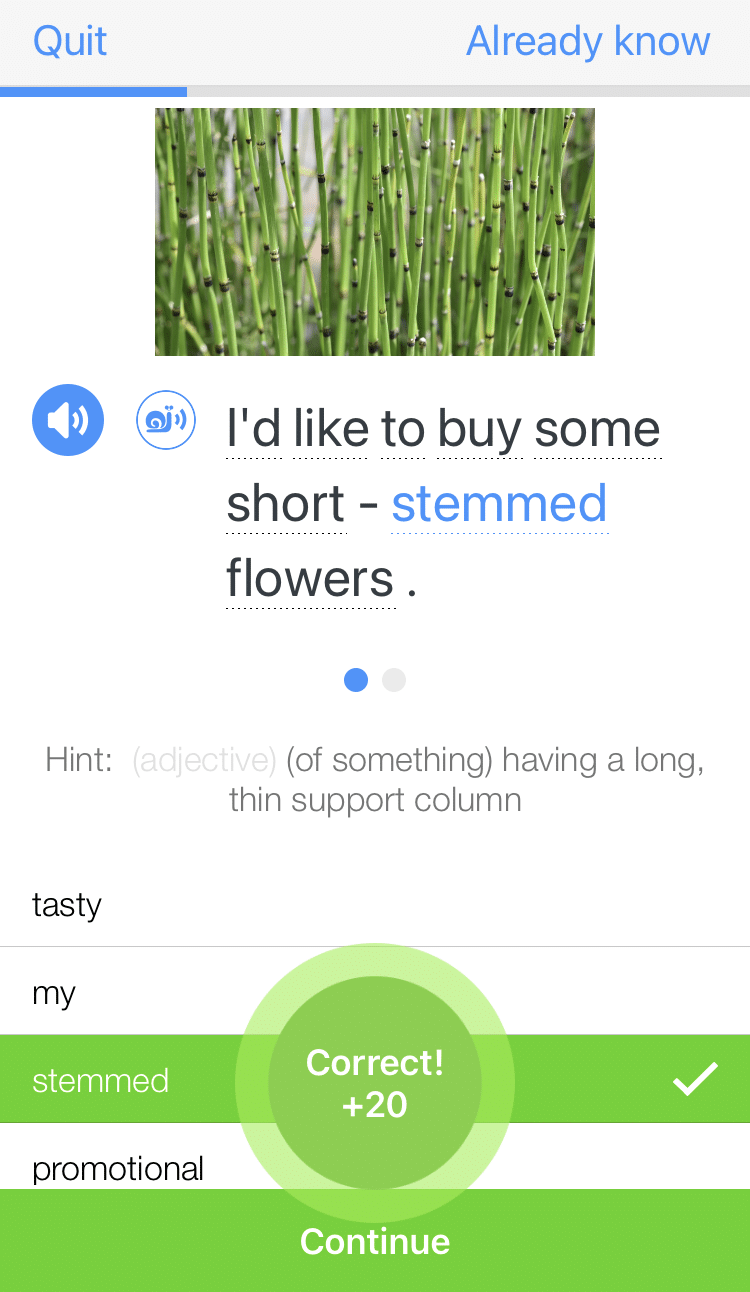
FluentU helps you learn fast with useful questions and multiple examples. Learn more.
The best part? FluentU remembers the vocabulary that you’re learning. It gives you extra practice with difficult words—and reminds you when it’s time to review what you’ve learned. You have a truly personalized experience.
Start using the FluentU website on your computer or tablet or, better yet, download the FluentU app from the iTunes or Google Play store. Click here to take advantage of our current sale! (Expires at the end of this month.)
Informal Greetings
Friendly Settings
When greeting friends, family, or acquaintances in casual settings, people often use informal greetings such as:
- Hey!
- Hi!
- What’s up?
- How’s it going?
- How are you doing?
These greetings are often accompanied by a smile or a wave, and are used to acknowledge the other person and start a conversation.
Casual Settings
In casual settings such as parties, concerts, or sports games, people often use informal greetings to acknowledge strangers or acquaintances. These greetings can include:
- Hey man!
- What’s new?
- What’s going on?
- Howdy!
- Yo!
These greetings are often accompanied by a nod or a handshake, and are used to start a conversation or show friendliness.
#8 Greetings in Letters and E-mails
Whether you are reaching out to a professional contact, engaging in a semi-formal dialogue, or connecting with a close friend, the opening salutation can influence the effectiveness of your communication. Here’s an expanded guide to help you navigate the nuances of crafting the perfect greeting for every situation, from the strictly professional to the warmly casual.
1. For Formal Communications
In formal communications, it’s crucial to adhere to traditional etiquette. This conveys professionalism and respect towards the recipient. Whether you’re addressing a potential employer a business associate, or making a formal request, the proper salutation can set a respectful tone for your message.
- “Dear ,”
-
“To Whom It May Concern,”
When the recipient’s name is unknown, this is a common but very formal greeting. It’s often used for letters of recommendation or formal complaints.
-
“Dear ,”
When writing to someone with a specific role but whose name you don’t know, such as “Dear Hiring Manager” or “Dear Editor,”
-
“Dear ,”
If you know the person but are still in a formal setting, use their full name without a title, for example, “Dear Jordan Bishop,”
2. For Semi-Formal Communications
Semi-formal communication strikes a balance between a warm rapport and professional courtesy. This style is often suitable for correspondence within your professional network, where a sense of familiarity exists, but a level of professionalism is still expected.
-
“Hello ,” or “Hi ,”
These are more casual but still appropriate for professional peers if you have an existing relationship or the industry is more relaxed.
-
“,”
This is casual and typically used when you have an established working relationship or the environment is quite informal.
-
“Greetings,”
It’s slightly more formal than “Hello” but less formal than “Dear.” This can be a good middle ground.
3. For Informal Communications
Informal greetings are reserved for those with whom you have a casual or personal relationship. These relaxed greetings convey warmth and friendliness, making them perfect for friends, close colleagues, or long-time clients with whom you have developed a more laid-back rapport.
-
“Hi ,”
This is friendly and informal, suitable for someone you know well personally.
-
“Hey ,”
It is very informal and best used with colleagues you’re close to or in environments where informal communication is the norm.
4. Email-Specific Greetings
- “Good , ,”
-
“!”
Using just the first name with an exclamation can be engaging and lively for informal business cultures or creative industries.
5. Situational Greetings
Certain occasions or times of year call for specialized greetings. Whether acknowledging a holiday, a particular day of the week, or a special event, these greetings help to share in the spirit of the occasion, adding relevance and a personal connection to your message.
-
“Season’s Greetings,”
Appropriate for holiday-themed messages.
-
“Happy , !”
A cheerful way to acknowledge the day, such as “Happy Friday, Mark!”
6. General Tips for Greetings in Letters and E-mails
It’s essential to consider general best practices when greeting someone in written communication. These tips ensure that regardless of the level of formality, your greetings are appropriate, respectful and set the desired tone for the interaction that follows.
- Always double-check the spelling of the recipient’s name.
- Match the level of formality to the relationship you have with the recipient and the norm in your industry.
- Consider the purpose of your communication. A job application might start with “Dear,” while a quick follow-up email might simply use “Hi.”
- Be cautious with humor or over-familiarity unless you know the recipient well.
#1 Greeting a Friend
When greeting a friend, the language is typically relaxed and informal, reflecting the closeness and familiarity of the relationship. The greetings can vary widely, from playful and casual to warm and caring, depending on the context and the nature of the friendship. The key is to convey friendliness and genuine interest in the other person’s well-being. Here are some ways to greet a friend.
- Hi Bryan! How are you?
- Hey James! How’ve you been?
-
Howdy
Howdy howdy!
! You alright, friend?
-
Yo
Not much. How about you?
! What’s going on, man?
- What’s up! Buddy?
- ?
- How’s life, mate?
-
Hiya
Yeah! How about you?
! Is everything fine?
- How’s it going? Long time, no see dear!
- ! Dude?
Note: Greeting a friend is always informal. However, you must be polite in your choice of words, tone, and body language while greeting them.
#3 Greeting an Elderly Person
When addressing an elderly person, it’s important to show respect and consideration. Greetings should be courteous and often slightly more formal, acknowledging their seniority. It is appropriate to use titles like Mr., Mrs., or Ms., along with a kind inquiry about their well-being. The tone should convey both respect and warmth. Find some examples below.
- Good afternoon Ms. Watson! How are you today?
- Hello sir! How are you?
- Hello ma’am! Would you care for a drink?
- Hi grandma! ((You can use what names you have for them, such as grammy or granny)
- Hello! May I talk to you?
- Hey! How are you, grandpa? I missed you a lot.
Note: Don’t mention someone’s age (i.e., senior citizen, old man, etc.) since it may sound impolite to some people. To many people, age is just a number. However, to learn to ask about someone’s age without offending them, you can read another post titled How to Ask Someone About Their Age.
Подготовка к устному высказыванию на английском по теме MY DAILY ROUTINE
Упражнение 1. Используя следующие карточки, расскажите о распорядке дня Джейми, Мелани, Анны, Джессики и Паула.
1 Расскажите о распорядке дня Джейми.

2 Расскажите о распорядке дня Мелани.
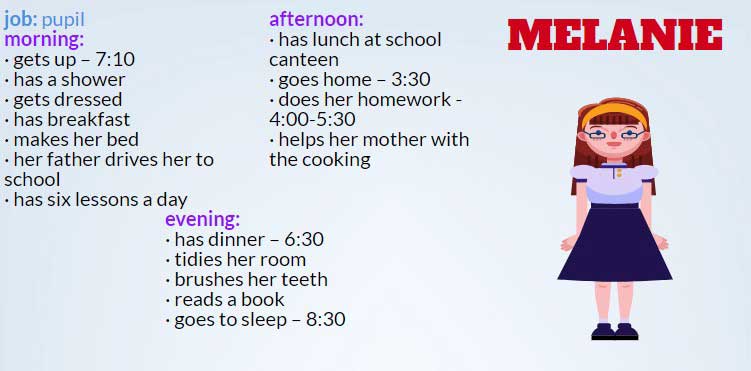
3 Расскажите о распорядке дня Анны
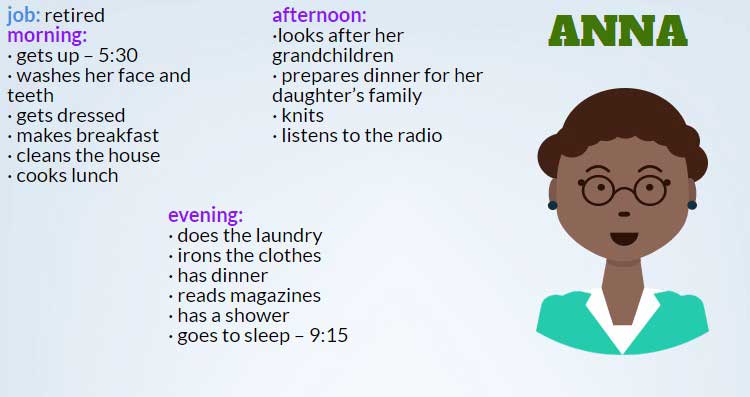
4 Расскажите о распорядке дня Джессики. Расскажите о распорядке дня Паула.

Упражнение 2. Ответьте на вопросы
- What time do you get up?
- Where do you have breakfast?
- What do you have for breakfast?
- Do you go to school in the morning or in the afternoon?
- What time do you have lunch?
- What do you do in the afternoon?
- When do you do your homework?
- Do you have a shower before going to bed?
- Do you watch TV at night?
- What is your favorite TV programme?
- What time do you go to bed?
Упражнение 3. Используя карточку, расскажите о своем распорядке дня на английском.
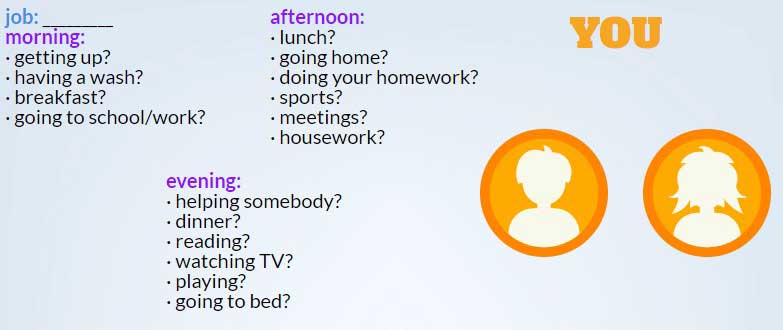
#6 Greeting a Job Interviewer
Greeting a job interviewer is all about making a positive and respectful first impression. It is crucial to use a polite and formal address and a professional demeanor. The greeting should communicate eagerness and gratitude for the opportunity, setting a tone of professionalism right from the start. Find some good examples below.
- Hello! It is a pleasure to meet you.
- Good morning! How are you today?
- Hello Mr. John! It is nice to meet you.
- Good afternoon! Thank you for the interview opportunity.
- How do you do, Ms. Jessie?
- Hello! My name is Robert Browning. I am glad you called me for an interview.
Informal Greetings in English
5. Hey
/ Hey man
/ Hi
You can use “hey” and “hi” to greet someone instead of “hello.” Both are particularly popular among younger people.
While “hi” is appropriate to use in any casual situation, “hey” is for people who have already met. If you say “hey” to a stranger, it might be confusing for that person because he or she will try to remember when you met before!
You can also add “man” to the end of “hey” when greeting males. Some people also use “hey man” to casually greet younger women, but only do this if you know the woman very well.
Remember that “hey” doesn’t always mean “hello.” “Hey” can also be used to call for someone’s attention.
6. Greeting a stranger
But what about introducing yourself to a stranger?
Speaking with strangers is often a dreaded (feared) task for many speaking in a second language, and for English learners it is no different. We have particular titles used for greeting strangers in English and usually, it is more formal speech.
For a full breakdown of how to politely greet strangers in English, you can just watch them doing it. But not in a creepy way—don’t go hide in the bushes and watch people interact.
Instead, use a learning program which lets you see authentic (real) videos of the English language in use naturally.
7. How’s it going?
/ How are you doing?
These are casual ways of asking “how are you?” If you’re trying to be particularly polite, stick with “how are you?” but otherwise, you can use these expressions to greet almost anyone.
The word “going” is usually shortened, so it sounds more like “go-in”. You can answer with “it’s going well” or “I’m doing well” depending on the question.
Although it’s not grammatically correct, most people just answer “good”—and you can too. Like when responding to “how are you?” you can also follow your answer by asking “and you?”
8. What’s up?
/ What’s new?
/ What’s going on?
These are some other informal ways of asking “how are you?” which are typically used to casually greet someone you have met before. Most people answer with “nothing” or “not much.”
Or, if it feels right to make small talk, you could also briefly describe anything new or interesting that’s going on in your life, before asking “what about you?” to continue the conversation.
9. How’s everything?
/ How are things?
/ How’s life?
These can be used to casually greet someone and ask how the person is doing, but most often these sentences are used to greet someone you already know. To these, you can answer “good” or “not bad.”
Again, if small talk feels appropriate, you could also briefly share any interesting news about your life, and then ask the person “what about you?” or another greeting question.
10. How’s your day?
/ How’s your day going?
These questions mean “how are you?” not just right now, but how you’ve been all day. You would use these greetings later in the day and with someone you see regularly.
For example, you might ask a co-worker one of these in the afternoon, or a cashier that you see at the grocery store every evening.
“It’s going well” is the grammatically correct response, but many people simply answer with “fine,” “good” or “alright.”
By the way, notice that “good,” “fine” or “not bad” are perfect answers to almost any greeting question.
11. Good to see you
/ Nice to see you
These casual greetings are used with friends, co-workers or family members that you haven’t seen in a while.
It’s common for close friends to hug when they greet each other, particularly if they haven’t seen each other in some time. So you might use this greeting along with a hug or handshake depending on your relationship with the person.
12. Long time no see
/ It’s been a while
These casual greetings are used when you haven’t seen someone in a long time, particularly if you meet that person unexpectedly.
How much is a long time? It depends on how often you normally see that person. For example, you could use one of these greetings if you normally see the person every week, but then don’t see them for a few months or more.
Usually, these phrases are followed by another question, like “how are you,” “how have you been?” or “what’s new?”
Why politeness formulas are essential
You might be thinking right about now that greetings in English and closing formula are a whole lot of hassle. That might be the case, but it’s still essential to master politeness formula.
Not only does using the correct greetings in English enhance your communication level, it’s also a simple mark of respect. When you’re interacting in the business world, a misstep at the earliest stage of saying hello can throw the whole exchange off. Imagine if you mistakenly greeted your company’s CEO with a casual “What’s up?”, or you might get laughed at by your colleagues if you enter the office saying, “How do you do?”.
Mastering politeness formula is about adapting your English communication to different circumstances and, above all, showing respect for your interlocutors. First impressions are very important, especially in the business world, and something as simple as the correct formal greetings in English could set you apart from an under-prepared colleague. This is also extremely important when it comes to situations such as presenting your company, where you must excel at being polite and using the correct formulas.
Concluding Thoughts
we’ve seen how saying hello in different ways matters a lot. Whether we’re chatting with a friend, meeting someone new, respecting an older person, serving a customer, working with others, at a job interview, during special times of the year, or writing a note, being good at greeting can make a great first impression.
Being able to greet well is a key skill. It makes people feel good, helps make friends, makes customers happy, shows respect, and can even help us get a job. As the seasons change, how we say hello can show we care and bring us closer to others.
Greeting is not just about words; it’s about kindness and showing we care about people’s feelings. With what we’ve learned, let’s go out and use our greetings to make real connections with everyone we meet.
#2 Greeting a Stranger
Greeting a stranger requires a respectful and courteous approach. It often involves a neutral tone and a polite form of address. These greetings are designed to initiate contact in a friendly manner without overstepping any personal boundaries, often prefaced with a gentle request or a kind question to acknowledge the other person’s presence and comfort. Here are some examples of greeting someone you have just met for the first time.
- Hi! Can I sit here?
- Hey! May I talk to you, please?
- Hello! Are you looking for any address?
- Good evening!
- How are you?
- How are you doing?
- Good morning to you.
- How do you do?
Note: To start a conversation with a stranger, you may ask for permission from them or make polite requests to talk to you. The above examples show how to do it as a part of greetings. If you know some other ways of doing it, please share them with us in the comment box.
Business Greetings and Formal Greetings
It’s best to begin by using formal greetings in most business situations, and then listen to how your co-workers or business partners greet you. It’s a good idea to wait until someone speaks casually with you before you speak casually with them. You may find that people will begin to use casual greetings with you over time, as you get to know each other better. Formal greetings are also used when you meet older people.
8. Good morning, Good afternoon, or Good evening
These are formal ways of saying “hello”, which change depending on the time of day. Keep in mind that “good night” is only used to say “good bye”, so if you meet someone late in the day, remember to greet them with “good evening”, rather than “good night”. Good morning can be made more casual by simply saying “morning”. You can also use “afternoon” or “evening” as informal greetings, but these are less commonly used.
9. It’s nice to meet you or Pleased to meet you
These greetings are formal and polite. If you say this to someone when you meet him or her for the first time, it will make you seem courteous. Remember to only use these greetings the first time you meet someone. Next time you see the person you can show that you remember him or her by saying “it’s nice to see you again”.
10. It’s an honor to meet you.
This is usually used when you meet someone important. This is a very formal greeting and it expresses respect.
And One More Thing…
If you like learning English through movies and online media, you should also check out FluentU. FluentU lets you learn English from popular talk shows, catchy music videos and funny commercials, as you can see here:

If you want to watch it, the FluentU app has probably got it.
The FluentU app and website makes it really easy to watch English videos. There are captions that are interactive. That means you can tap on any word to see an image, definition, and useful examples.

FluentU lets you learn engaging content with world famous celebrities.
For example, when you tap on the word «searching,» you see this:

FluentU lets you tap to look up any word.
Learn all the vocabulary in any video with quizzes. Swipe left or right to see more examples for the word you’re learning.

FluentU helps you learn fast with useful questions and multiple examples. Learn more.
The best part? FluentU remembers the vocabulary that you’re learning. It gives you extra practice with difficult words—and reminds you when it’s time to review what you’ve learned. You have a truly personalized experience.
Start using the FluentU website on your computer or tablet or, better yet, download the FluentU app from the iTunes or Google Play store. Click here to take advantage of our current sale! (Expires at the end of this month.)
Here are some basic greetings in English:
| Greeting | Meaning/Usage |
|---|---|
| Hello | Universal greeting |
| Hi | Informal, friendly |
| Hey | Casual and friendly |
| Good morning | Greeting in the morning |
| Good afternoon | Polite greeting in the afternoon |
| Good evening | Polite greeting in the evening |
| How are you? | Asking about someone’s well-being |
| What’s up? | Informal way to ask how someone is |
| How’s it going? | Casual way to ask about someone’s situation |
| Nice to meet you | Used when meeting someone for the first time |
| Hi there | Informal and friendly |
| Greetings | Formal way to say hello |
| Howdy | Informal and often used in certain regions |
| Morning | Casual, short version of “Good morning” |
| Afternoon | Casual, short version of “Good afternoon” |
| Evening | Casual, short version of “Good evening” |
| How have you been? | Asking about someone’s recent experiences |
| Long time no see | Used when you haven’t seen someone for a while |
| Hey, what’s happening? | Casual way to initiate a conversation |
| Yo | Very informal and casual |
How to learn commercial English with GlobalExam’s Business English platform
GlobalExam is a sophisticated e-learning platform that is 100% online! If you’re thinking about taking your mission to learn English vocabulary into the digital sphere, this is the place for you!
When you sign up to learn English using our Business English platform, you’ll get access to a wide range of grammar and vocabulary exercises to learn English in the context of real-life business situations. As you progress through the situations, units, and modules, you can track your progress and see where you are in your mission to learn English. This is a huge advantage to digital learning: when we learn English online, we can keep a close eye on our strengths and weaknesses, tick off our goals, and stay motivated all the way through.
You don’t need to be comfortable in English to learn English online with us. Our platform is adapted to beginner, intermediate and expert-level English speakers, so you’ll be able to find your niche.
You will be able to easily apply all the skills you will acquire in various situations, such as writing a perfect cover letter for instance.
Make progress in English through virtual lessons
Have you considered adding virtual lessons to your strategy to learn English online? GlobalExam can help you with that. Our new virtual learning option allows you to learn English in an interactive way either individually or in a group, under the guidance of qualified English teachers.
If you’re looking to deepen your knowledge on politeness formula and closing formula in English communication, a group lesson on one of the following topics could be for you:
- Making a phone call
- Planning meetings
- Giving presentations
- Participating in video and conference calls
If it’s an individual approach to learn English that suits you, then a private lesson on the topic of your choice is the way to go.
Virtual lessons are a great way to consolidate your existing efforts to learn English online and to put your skills into practice with other learners. Why not try out your new knowledge on using greetings in English to say hello to your new virtual learning peers?
See you online!
READING COMPREHENSION по теме Распорядок дня (Daily Routine)
Exercise 1. Read the text twice.
Greg’s Daily Routine
Greg is an American boy. He lives in Arlington, Texas. He lives with his family in a modern house. He is eleven years old and he has got an older brother, Alex, and a younger sister, Emma.
He starts his day at about half past six. He gets up, goes to the bathroom, takes a shower, brushes his teeth and get dressed. Then he has breakfast and at a quarter to seven he leaves home and catches the bus to school.
Classes begin at half past seven. He usually has lunch at the school canteen at half past twelve. After school, at a quarter past five, he goes home. There he does his school homework and when he finishes it he helps his Mum laying the table. At half past seven the family dines together.
Greg is a very helpful boy, so he helps his mother cleaning up everything after dinner.
He usually watches TV for a while after dinner and at about ten o’clock the most he brushes his teeth again, puts on his Spider Man pajamas and goes to bed. His parents always kiss him good night before he gets asleep. Greg is a very happy boy!
Exercise 2. True or False.
- Greg is an American boy.
- Greg lives in a modern flat.
- Greg is eleven years old.
- Greg has got two brothers.
- Greg wakes up at eight o’clock.
- Greg walks to school.
- Greg classes begin at half past eight.
- Greg and his family have dinner at half past seven.
Exercise 3. Match the antonyms
|
modern older starts leaves begin together helpful happy |
enters alone end old-fashioned unhappy younger finishes unhelpful |
Exercise 4. Answer the questions
- Where does Greg live?
- What’s his sister’s name?
- What time does he wake up?
- Does he have breakfast at home?
- What time does he leave home?
- Where does he have lunch?
- When does he return home?
- Does he do his homework at school or at home?
- Is he a helpful boy?
Exercise 5. What about you? What’s your daily routine like?
Sample Conversation: Greetings in English
1. Formal Greetings
Situation: At a business conference, Mr. Thompson, a senior executive from a renowned company, meets Ms. Rivera, a potential client.
Mr. Thompson: Good afternoon, Ms. Rivera. It’s a pleasure to meet you. How has your experience been at the conference so far?
Ms. Rivera: Good afternoon, Mr. Thompson. The conference has been quite informative, and I’ve had the opportunity to meet several industry leaders. How has it been for you?
Mr. Thompson: It’s been productive. Our company always looks forward to events like these to connect with potential partners and clients. I hope we can discuss potential collaborations during our meeting tomorrow.
Ms. Rivera: Indeed, I’m looking forward to our discussion. I believe there are areas where our companies can benefit from a partnership.
2. Informal Greetings
Situation: Jake runs into his old college friend, Lucy, at a local coffee shop.
Jake: Hey Lucy! Long time no see! How’ve you been?
Lucy: Jake! Wow, it’s been ages! I’ve been good, just busy with work and stuff. How about you? Still playing guitar?
Jake: Oh, you bet! Just for fun these days. And yeah, work keeps me on my toes too. We should catch up properly sometime soon.
Lucy: Totally! Let’s grab dinner next week. I’d love to hear more about your adventures.
3. Semi-formal Greetings
Situation: At a community meeting, Sarah, a local resident, speaks with Councilman Rodriguez about a new park initiative.
Sarah: Good evening, Councilman Rodriguez. I wanted to thank you for supporting the new park initiative. It’ll be great for the kids in our neighborhood.
Councilman Rodriguez: Good evening, Sarah. I appreciate your kind words. It’s essential to have spaces where our community can come together. How do you feel about the proposed design?
Sarah: I think it’s a good start. I do have a few suggestions, especially regarding the play area for kids. Maybe we could discuss it further at the next meeting?
Councilman Rodriguez: Absolutely, Sarah. Feedback from residents like you is invaluable. I look forward to hearing your ideas.




























